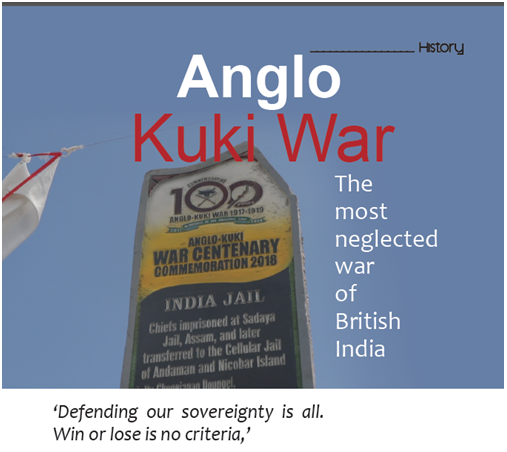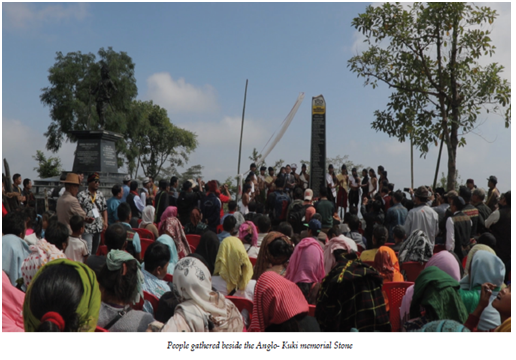
‘Defending our sovereignty is all. Win or lose is no criteria,’ was the clarion call given at the commencement of the Anglo-Kuki war of 1917-19 by the Commander-in Chief of the Kuki Army, General TintongHaokip. ‘A true Kuki warrior was unfazed by the British imperialist following the Jampi Conclave of March 1917’ were also inscribed at the only Anglo-Kuki War memorial Complex at Songpi in Churachandpur district of Manipur, dedicated to General TintongHaokip.
Anglo-Kuki War is probably the most neglected historical event of British India even as it was counted as one of the costliest expeditions where the British used all available resources to quickly subjugate an ill-equipped Kukis. From the Kuki’s perspective, it was the greatest events that continue to inspire as a handful of Kuki warriors taunted the mighty British Empire for two years using guerilla warfare where its troops were ambushed, harassed and tormented.
“The war was a modern warfare, one in which the British were thinking of even using fighter aircrafts to overcome difficulties of terrains,” said Dr. Robert ThongkholalHaokip, Asst. Prof. JNU who is one of the authors of the book, tilted, ‘The Anglo-Kuki War, 1917-1919, a frontier uprising against imperialism during the First World War’ released on the day the Anglo-Kuki War Centenary Commemoration was held.
The JNU professor asserted that if one was to judge by the 1977 Geneva Convention of military engagement, most of the military tactics, employed by the British during the Anglo-Kuki War violated the UN Convention.
“The British were desperate to crush the morale of the Kukis so that they would not revolt again during the British rule. However the Kukis took their revenge by fighting against the British during the Second World War by siding with the Japanese and Subhas Chandra Bose’s INA,” revealed Dr. Haokip.
In January of 1917 the British Indian government had ordered the Maharaja of Manipur to supply non-combatants for its Labour Corps for the First World War in France. The Kukis who settled in the hills, refused to fall in line even as hundreds were recruited from the valley.
There is a customary belief amongst the Kukis and kindred Chin-Mizo group of people that said, ‘if you die in foreign land your soul will wonder and will not reach Mittikho or heaven.’ This taboo dissuaded the Kukis from opting to sail to foreign shores and fight there or be engaged in Labour Corps. The resistance eventually resulted into what is called the Great Kuki Rebellion or the Anglo-Kuki War that lasted for two full years.
After the political agent of Manipur at that time failed to convince the Kukis diplomatically, some of the Kuki Chiefs in southern Manipur tried to negotiate against being recruited to the Labour Corps, offering tax in cash and kind. However, the negotiation failed. Eventually the intemperate political officer went to Lonpi (also called Mompi by the British) a Kuki dominated area and set the village on fire. This angered the Kukis.
By December 1917, the Kuki Chiefs from Assam, Manipur, Naga Hills and from Burma gathered in Chashad in Ukhrul district and resolved to fight against the British. General TintongHaokip led the Kuki warriors in the war that was fought in the winters of 1917-1918 and 1919.
During the first winter of 1917-18, the British thought it was a small uprising just like the Abor Uprising in Upper Assam. But to their surprise, it turned to be a well organized, coordinated through clan lineage.The political agent toured the southern parts of Manipur and burnt down villages, killed livestock and burnt granaries employing what is called in war strategy the scorchedearth politics. The anticipated surrenders of the Kuki warriors did not happened.
In the second operation of 1919, the British were better prepared. While they were clueless of their own defense during the surprise attacks and guerrilla warfare of the Kukis in the first engagement, for the second operation, British had a strategy.
“The Kukis areas in Manipur like the Somra tract and other parts were divided in six divisions. For example the northeast part that is the present Tamenglong district, the British used four columns. From Bishnupur, one column went and attacked certain areas where the rebels were held up. From Silchar and different places surprise attacks were mounted usingmodern guns,”said Dr. Haokip.
Sunzu Bachaspatimayum
To read the further article please get your copy of Eastern Panorama March issue @http://www.magzter.com/IN/Hill-Publications/Eastern-Panorama/News/ or mail to contact @easternpanorama.in


